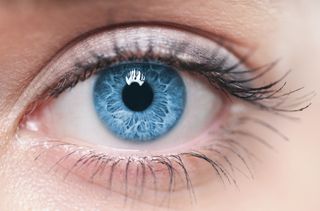Your pupils can count … sort of
Pupils expand when there are more objects to look at.

Your pupils might be able to count … sort of. New research suggests a person's pupil size can change based on the number of objects an individual observes in their visual field.
Pupils are holes located in the center of the eye, which change size to regulate the amount of light that enters the eye based on how much is available in the environment. The response of our pupils to light "is one of the most basic sensory responses," the authors wrote in the new study. But pupils have been found to change size based on factors other than light, such as arousal, Live Science previously reported.
The researchers of the new study hypothesized that pupils may also change size based on the number of objects that a person sees in their environment.
Related: 3 ways technology affects your eyes
It's thought that most species have a certain "number sense," co-author David Burr, a professor at the University of Sydney and the University of Florence, said in the statement. Previous research has suggested that humans may develop a "crude number discrimination" as soon as a few hours after birth, according to the study.
"When we look around, we spontaneously perceive the form, size, movement and color of a scene. Equally spontaneously, we perceive the number of items before us," Burr said. "This ability, shared with most other animals, is an evolutionary fundamental: It reveals immediately important quantities, such as how many apples there are on the tree, or how many enemies are attacking."
To figure out if this ability lies within the pupils, the researchers presented 16 adult participants with images of dots on a monitor in an otherwise quiet, dark room. As the participants stared at the screen, without being asked to count the dots, a machine measured their pupil sizes.
Sign up for the Live Science daily newsletter now
Get the world’s most fascinating discoveries delivered straight to your inbox.
The images contained either 18 or 24 black or white dots, and each dot was either separate or coupled up with a small line, giving the person the illusion that there were fewer dots on the monitor than there actually were, according to the statement.
The researchers found that the size of the participants' pupils changed depending on how many dots they perceived. The participants' pupils dilated, or expanded, when they perceived a greater number of dots and constricted when they perceived fewer dots.
The finding suggests that the pupil is equipped with some mechanism that can sense quantity, according to the statement. "This result shows that numerical information is intrinsically related to perception," lead author Elisa Castaldi, a postdoctoral researcher at the University of Pisa said in the statement. "This could have important, practical implications."
For example, similar methods could be employed to detect dyscalculia, a learning disability that makes people have trouble doing math, in very young children, she said. "It is very simple: Subjects simply look at a screen without making any active response, and their pupillary response is measured remotely."
The findings were published Oct. 12 in the journal Nature Communications.
Originally published on Live Science.

Yasemin is a staff writer at Live Science, covering health, neuroscience and biology. Her work has appeared in Scientific American, Science and the San Jose Mercury News. She has a bachelor's degree in biomedical engineering from the University of Connecticut and a graduate certificate in science communication from the University of California, Santa Cruz.